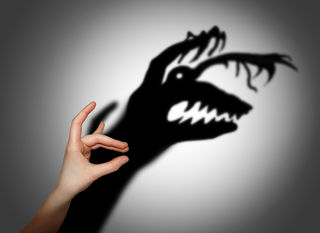
One in four people over 40 are on anti-depressants.[1] More than 10 million people, myself included, weigh over 500 pounds; drug addiction and alcoholism are at an all-time high (no pun intended), and the economy is tighter than my skinny jeans. It’s a jungle out there: terrorists are planting bombs like they’re daffodils and mad gunmen randomly opening fire on schools, churches, airports, train stations and shopping malls – wherever, whenever and for reasons none of us understands. No wonder so many people are on anti-depressants, drunk, stoned or in a carb coma – there is more stress than oxygen in the air. Stress is a major contributor to most diseases, as well as domestic and workplace violence. [2-8] Dr. Alex Korb, renown depression expert, and author of The Upward Spiral says stress is a major factor in depression. So, "Houston we got a problem.”
We have to stop stress at the source, which is not the person, place or thing that we find stressful, but our perception of threat versus perception of control surrounding the person, place or thing.[9-17] The solution is simple: brutal honesty, meticulous self-scrutiny, and unconditional acceptance of people, places and things. Yes, this is counterintuitive – but let’s connect the dots.
Neurosignatures

Everything we see, hear, touch, smell or taste creates a unique neurosignature in our brain. Neurosignatures are like ink marks on a piece of paper; they cannot be erased only overwritten by other neurosignatures (like changing an 8 to a 0 on a check).[18] There are two types of neurosignatures: bottom-up and top-down. In bottom-up neurosignatures, sensory information travels from the body up to brain. We create top-down neurosignatures with thought and the information travels from the brain down to the body.[18-20] Once we create a neurosignature, it is integrated into our brains, like putting salt in a vegetable soup. The soup and the salt change each other. The soup now tastes like this soup with salt, and the salt now tastes like salt in this soup.[18-20]
Every time you experience something similar to a neurosignature, it creates a new neurosignature and activates the old neurosignature. The more a neurosignature is activated, the more pronounced it becomes. This is great news if you are overwriting negative neurosignatures by continuously re-creating positive top-down neurosignatures. On the flipside, if thought, the media or experiences constantly activate negative neurosignatures it gets ugly because negative neurosignatures create stress. [18-20]
Stress Regulation
The brain processes stress as threat, and prepares for the eventuality of fight-or-flight, by going into “survive now, ask questions later,” mode.[21-25] Because when our ancestors heard a sound, it could be tumbleweed or a lion. If they ran immediately they stood a better chance of surviving than if they stopped to think about it. Hence, the brain structures involved cannot distinguish between perceived and actual threat. Dr. Stephen Kosslyn demonstrated this when he found no differences in the brain response of his subjects to actual or vividly imagined events in a Positron Emission Tomography (PET) study.[26]

This is problematic because distorted perception leads to over use of our stress response, which causes our body’s protective mechanisms to go from assets to liabilities. It’s like riding your car brakes down a hill and wearing down the brake pads. [23, 24] The surges in blood pressure and quick glucose metabolism, caused by the stress response, are assets if you are actually preparing to fight or run. However, when chronically engaged, your stress responses become cardiovascular disease, diabetes, and metabolic disorders. [25] Excess stress and chronic illness often leads to depression, anxiety, and other Prozac-friendly states of mind. However, it does not have to come to this, if you change your perception of control and threat with brutal honesty.
Brutal Honesty

The truth may not always be ugly, but it is never pretty – especially when private demons are involved. You have to ask yourself “Who am I and what do I say I do versus what I actually do?” What you say you do is who you feel you need to be; what you actually do is who you really are. You have to explore that discrepancy to understand your compatibility with the world and assess the intrinsic and consensual realities of your life.
Intrinsic realities are things that are real and exist in nature, like fire, disease, breathing, body types and parades.
Humans create consensual realities and make them real by subscribing to them, such as beauty, class, and total worth based solely on wealth or occupation. Who you really are and what you really want and need is an intrinsic reality. Who you are told you should be, and what you are told you should want is often a consensual reality. If you believe you are ugly, it is not because you are ugly – it is because you have subscribed to an incompatible consensual reality.

Unsubscribing from incompatible consensual realities will increase the perception of control and decrease the perception of threat by increasing your perception of social worth. This decreases the perception of threat because we are a social species and for our ancestors social exclusion meant certain death. So the old mammal brain closely monitors indicators of social worth - many of which, in the modern world, are consensual realities.
You must also accept people, places and things as they are. Acceptance is not acquiescence, apathy, passiveness, complacency, or endorsement – it is just more brutal truth. You have no control over people, places, or things. You only control your response – and that’s all you need to control. When you pass judgments on other people, places or things, they become threatening. “Something is not as it should be” will threaten the brain every day, all day long. Conversely, “I’m not into this, but this is how this is supposed to be, so I will respond in this way” increases the perception of control and decreases the perception of threat.
In the human economy we are the pennies, and various groups and nations are the nickels, dimes, quarters and dollars. If we each take care of just one penny, the nickels, dimes, quarters and dollars will take care of themselves. And we will have a healthier social economy in a kinder, Prozac-free world. ---Remain fabulous and phenomenal.
Join my email list to receive notifications of new posts
Or visit me at:
UCLA Center for the Neurobiology of Stress
References
1. Wehrwein, P. Astounding increase in antidepressant use by Americans. 2011; Available from: http://www.health.harvard.edu/blog/astounding-increase-in-antidepressan….
2. Ramachandruni, S., E. Handberg, and D.S. Sheps, Acute and chronic psychological stress in coronary disease. Curr Opin Cardiol, 2004. 19(5): p. 494-9.
3. Ziegelstein, R.C., Acute emotional stress and cardiac arrhythmias. JAMA, 2007. 298(3): p. 324-9.
4. Buruck, G., et al., Acute psychosocial stress and emotion regulation skills modulate empathic reactions to pain in others. Front Psychol, 2014. 5: p. 517.
5. Porcelli, A.J., A.H. Lewis, and M.R. Delgado, Acute stress influences neural circuits of reward processing. Front Neurosci, 2012. 6: p. 157.
6. Koob, G.F., et al., Addiction as a stress surfeit disorder. Neuropharmacology, 2014. 76 Pt B: p. 370-82.
7. Hellhammer, J., et al., Allostatic load, perceived stress, and health: a prospective study in two age groups. Ann N Y Acad Sci, 2004. 1032: p. 8-13.
8. Legato, M.J., The allostatic load: how stress makes us sick. Gend Med, 2010. 7(5): p. 458-60.
9. Joukhador, J., F. Maccallum, and A. Blaszczynski, Differences in cognitive distortions between problem and social gamblers. Psychol Rep, 2003. 92(3 Pt 2): p. 1203-14.
10. Cornwell, B.R., et al., Evoked amygdala responses to negative faces revealed by adaptive MEG beamformers. Brain Res, 2008. 1244: p. 103-12.
11. Staebler, K., et al., Facial emotional expression in reaction to social exclusion in borderline personality disorder. Psychol Med, 2011. 41(9): p. 1929-38.
12. Miyahara, M., et al., Functional connectivity between amygdala and facial regions involved in recognition of facial threat. Soc Cogn Affect Neurosci, 2013. 8(2): p. 181-9.
13. Bruhl, A.B., et al., Neural correlates of altered general emotion processing in social anxiety disorder. Brain Res, 2011. 1378: p. 72-83.
14. Das, P., et al., Pathways for fear perception: modulation of amygdala activity by thalamo-cortical systems. Neuroimage, 2005. 26(1): p. 141-8.
15. Carr, D., K.J. Jaffe, and M.A. Friedman, Perceived interpersonal mistreatment among obese Americans: do race, class, and gender matter? Obesity (Silver Spring), 2008. 16 Suppl 2: p. S60-8.
16. Giorello, G. and C. Sinigaglia, Perception in action. Acta Biomed, 2007. 78 Suppl 1: p. 49-57.
17. Li, C.S., et al., Perceptual alternation in obsessive compulsive disorder--implications for a role of the cortico-striatal circuitry in mediating awareness. Behav Brain Res, 2000. 111(1-2): p. 61-9.
18. Salt, W., Irritable Bowel Syndrome and The Mind Body Connection. . 2002, Columbus, OH: Parkview Publsihing
19. Pert, C., Molecules of Emotion. 1997, New York, New York: Scribner.
20. Pert, C.B., The wisdom of the receptors: neuropeptides, the emotions, and bodymind. 1986. Adv Mind Body Med, 2002. 18(1): p. 30-5.
21. McEwen, B.S., Brain on stress: how the social environment gets under the skin. Proc Natl Acad Sci U S A, 2012. 109 Suppl 2: p. 17180-5.
22. McEwen, B.S., Stress and hippocampal plasticity. Annu Rev Neurosci, 1999. 22: p. 105-22.
23. McEwen, B.S., Stress and the aging hippocampus. Front Neuroendocrinol, 1999. 20(1): p. 49-70.
24. McEwen, B.S., Physiology and neurobiology of stress and adaptation: central role of the brain. Physiol Rev, 2007. 87(3): p. 873-904.
25. McEwen, B.S., Protective and damaging effects of stress mediators: central role of the brain. Dialogues Clin Neurosci, 2006. 8(4): p. 367-81.
26. Kosslyn SM, T.W., Sukel KE, Alpert NM., Two types of image generation: evidence from PET. . Cogn Affect Behav Neurosci., 2005 Mar;. 5((1):): p. 41-53.




